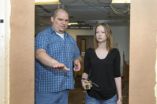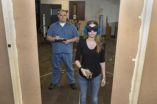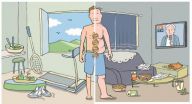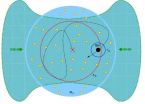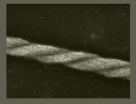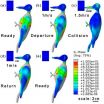(Press-News.org) Visual impairment comes in many forms, and it's on the rise in America.
A University of Cincinnati experiment aimed at this diverse and growing population could spark development of advanced tools to help all the aging baby boomers, injured veterans, diabetics and white-cane-wielding pedestrians navigate the blurred edges of everyday life.
These tools could be based on a device called the Enactive Torch, which looks like a combination between a TV remote and Captain Kirk's weapon of choice. But it can do much greater things than change channels or stun aliens.
Luis Favela, a graduate student in philosophy and psychology, has found the torch enables the visually impaired to judge their ability to comfortably pass through narrow passages, like an open door or busy sidewalk, as good as if they were actually seeing such pathways themselves.
The handheld torch uses infra-red sensors to "see" objects in front of it. When the torch detects an object, it emits a vibration -- similar to a cellphone alert – through an attached wristband. The gentle buzz increases in intensity as the torch nears the object, letting the user make judgments about where to move based on a virtual touch.
"Results of this experiment point in the direction of different kinds of tools or sensory augmentation devices that could help people who have visual impairment or other sorts of perceptual deficiencies. This could start a research program that could help people like that," Favela says.
Favela presented his research "Augmenting the Sensory Judgment Abilities of the Visually Impaired" at the American Psychological Association's (APA) annual convention, held Aug. 7-10 in Washington, D.C. More than 11,000 psychology professionals, scholars and students from around the world annually attend APA's convention.
A GROWING POPULATION IN NEED
Favela studies how people perceive their environment and how those perceptions inform their judgments. For this experiment, he was inspired by what he knew about the surging population of visually impaired Americans.
The Centers for Disease Control and Prevention (CDC) predicts that more than 6 million Americans age 40 and older will be affected by blindness or low vision by 2030 – double the number from 2004 – due to diabetes or other chronic diseases and the rapidly aging population. The CDC also notes that vision loss is among the top 10 causes of disability in the U.S., and vision impairment is one of the most prevalent disabilities in children.
"In my research I've found that there's an emotional stigma that people who are visually impaired experience, particularly children," Favela says. "When you're a kid in elementary school, you want to blend in and be part of the group. It's hard to do that when you're carrying this big, white cane."
SUBSTITUTING SIGHT WITH TOUCH
In Favela's experiment, 27 undergraduate students with normal or corrected-to-normal vision and no prior experience with mobility assistance devices were asked to make perceptual judgments about their ability to pass through an opening a few feet in front of them without needing to shift their normal posture. Favela tested participants' judgments in three ways: using only their vision, using a cane while blindfolded and using the Enactive Torch while blindfolded. The idea was to compare judgments made with vision against those made by touch.
The results of the experiment were surprising. Favela figured vision-based judgments would be the most accurate because vision tends to be most people's dominant perceptual modality. However, he found the three types of judgments were equally accurate.
"When you compare the participants' judgments with vision, cane and Enactive Torch, there was not a significant difference, meaning that they made the same judgments," Favela says. "The three modalities are functionally equivalent. People can carry out actions just about to the same degree whether they're using their vision or their sense of touch. I was really surprised."
Favela plans additional experiments requiring more complicated judgments, such as the ability to step over an obstacle or to climb stairs. With further study and improvements to the Enactive Torch, Favela says similar tools that augment touch-based perception could have a significant impact on the lives of the visually impaired.
"If the future version of the Enactive Torch is smaller and more compact, kids who use it wouldn't stand out from the crowd, they might feel like they blend in more," he says, noting people can quickly adapt to using the torch. "That bodes well, say, for someone in the Marines who was injured by a roadside bomb. They could be devastated. But hope's not lost. They will learn how to navigate the world pretty quickly."
INFORMATION:
Additional contributors to Favela's research were UC psychology professors Michael Riley and Kevin Shockley, and Anthony Chemero, professor of philosophy and psychology.
'Seeing' through virtual touch is believing
Surprising results from University of Cincinnati research could lead to new ways to help the visually impaired better navigate everyday life
2014-08-11
ELSE PRESS RELEASES FROM THIS DATE:
Aberrant mTOR signaling impairs whole body physiology
2014-08-11
The protein mTOR is a central controller of growth and metabolism. Deregulation of mTOR signaling increases the risk of developing metabolic diseases such as diabetes, obesity and cancer. In the current issue of the journal Proceedings of the National Academy of Sciences, researchers from the Biozentrum of the University of Basel describe how aberrant mTOR signaling in the liver not only affects hepatic metabolism but also whole body physiology.
The protein mTOR regulates cell growth and metabolism and thus plays a key role in the development of human disorders. In the ...
Not only in DNA's hands
2014-08-11
Blood stem cells have the potential to turn into any type of blood cell, whether it be the oxygen-carrying red blood cells, or the many types of white blood cells of the immune system that help fight infection. How exactly is the fate of these stem cells regulated? Preliminary findings from research conducted by scientists from the Weizmann Institute and the Hebrew University are starting to reshape the conventional understanding of the way blood stem cell fate decisions are controlled thanks to a new technique for epigenetic analysis they have developed. Understanding ...
All-you-can-eat at the end of the universe
2014-08-11
At the ends of the Universe there are black holes with masses equaling billions of our sun. These giant bodies – quasars – feed on interstellar gas, swallowing large quantities of it non-stop. Thus they reveal their existence: The light that is emitted by the gas as it is sucked in and crushed by the black hole's gravity travels for eons across the Universe until it reaches our telescopes. Looking at the edges of the Universe is therefore looking into the past. These far-off, ancient quasars appear to us in their "baby photos" taken less than a billion years after the Big ...
Nanocubes get in a twist
2014-08-11
Nanocubes are anything but child's play. Weizmann Institute scientists have used them to create surprisingly yarn-like strands: They showed that given the right conditions, cube-shaped nanoparticles are able to align into winding helical structures. Their results, which reveal how nanomaterials can self-assemble into unexpectedly beautiful and complex structures, were recently published in Science.
Dr. Rafal Klajn and postdoctoral fellow Dr. Gurvinder Singh of the Institute's Organic Chemistry Department used nanocubes of an iron oxide material called magnetite. As ...
How the woodpecker avoids brain injury despite high-speed impacts via optimal anti-shock body structure
2014-08-11
Designing structures and devices that protect the body from shock and vibrations during high-velocity impacts is a universal challenge.
Scientists and engineers focusing on this challenge might make advances by studying the unique morphology of the woodpecker, whose body functions as an excellent anti-shock structure.
The woodpecker's brain can withstand repeated collisions and deceleration of 1200 g during rapid pecking. This anti-shock feature relates to the woodpecker's unique morphology and ability to absorb impact energy. Using computed tomography and the construction ...
Megascale icebergs run aground
2014-08-11
Scientists from the Alfred Wegener Institute, Helmholtz Centre for Polar and Marine Research (AWI) have found between Greenland and Spitsbergen the scours left behind on the sea bed by gigantic icebergs. The five lineaments, at a depth of 1,200 metres, are the lowest-lying iceberg scours yet to be found on the Arctic sea floor. This finding provides new understanding of the dynamics of the Ice Age and the extent of the Arctic ice sheet thousands of years ago. In addition, the researchers could draw conclusions about the export of fresh water from the Arctic into the ...
Western Wall weathering: Extreme erosion explained
2014-08-11
Visitors to the Western Wall in Jerusalem can see that some of its stones are extremely eroded. This is good news for people placing prayer notes in the wall's cracks and crevices, but presents a problem for engineers concerned about the structure's stability.
The Western Wall is a remnant of the ancient wall that surrounded the courtyard of the Jewish Temple in Jerusalem. It is located in Jerusalem's Old City at the foot of the Temple Mount.
To calculate the erosion in the different kinds of limestone that make up the Western Wall, researchers from the Hebrew University ...
Celebrity promotion of charities 'is largely ineffective,' says research
2014-08-11
Celebrity promotion of charities is ineffective at raising awareness, but can make the stars more popular with the public, new research says.
According to journal articles by three UK academics, "the ability of celebrity and advocacy to reach people is limited" and celebrities are "generally ineffective" at encouraging people to care about "distant suffering".
The research, by Professor Dan Brockington, of The University of Manchester, Professor Spensor Henson, University of Sussex, and Dr Martin Scott, University of East Anglia, is published at time when many celebrities ...
A new cause of osteoarthritis identified by research on a rare disease
2014-08-11
A new mechanism of joint destruction caused by a natural material that grinds away healthy cartilage and worsens osteoarthritis has been identified in human hip joints for the first time by University of Liverpool scientists.
The scientists, with Professor Alan Boyde and colleagues from Queen Mary University of London, were studying the hip of a man with the genetic condition, alkaptonuria (AKU), This is a metabolic disease in which a substance called homogentisic acid accumulates in joint cartilage, causing changes to its physical properties.
The study revealed ...
Challenges and strategies for women pursuing STEM careers
2014-08-11
As a national push continues to recruit talented girls and young women into math and science-related careers, a new study underlines the importance of mentoring and other social support systems for women pursuing those research professions. Mary Jean Amon, a doctoral student in the University of Cincinnati's psychology program, will present her findings at the annual convention of the American Psychological Association in Washington, D.C.
Amon's study uncovered three themes that emerged as women examined the effects of gender stereotypes in STEM fields: career strategies, ...
LAST 30 PRESS RELEASES:
Decoupling the HOR enhancement on PtRu: Dynamically matching interfacial water to reaction coordinates
Sulfur isn’t poisonous when it synergistically acts with phosphine in olefins hydroformylation
URI researchers uncover molecular mechanisms behind speciation in corals
Chitin based carbon aerogel offers a cleaner way to store thermal energy
Tracing hidden sources of nitrate pollution in rapidly changing rural urban landscapes
Viruses on plastic pollution may quietly accelerate the spread of antibiotic resistance
Three UH Rainbow Babies & Children’s faculty elected to prestigious American Pediatric Society
Tunnel resilience models unveiled to aid post-earthquake recovery
Satellite communication systems: the future of 5G/6G connectivity
Space computing power networks: a new frontier for satellite technologies
Experiments advance potential of protein that makes hydrogen sulfide as a therapeutic target for Alzheimer’s disease
Examining private equity’s role in fertility care
Current Molecular Pharmacology achieves a landmark: real-time CiteScore advances to 7.2
Skeletal muscle epigenetic clocks developed using postmortem tissue from an Asian population
Estimating unemployment rates with social media data
Climate policies can backfire by eroding “green” values, study finds
Too much screen time too soon? A*STAR study links infant screen exposure to brain changes and teen anxiety
Global psychiatry mourns Professor Dan Stein, visionary who transformed mental health science across Africa and beyond
KIST develops eco-friendly palladium recovery technology to safeguard resource security
Statins significantly reduce mortality risk for adults with diabetes, regardless of cardiovascular risk
Brain immune cells may drive more damage in females than males with Alzheimer’s
Evidence-based recommendations empower clinicians to manage epilepsy in pregnancy
Fungus turns bark beetles’ defenses against them
There are new antivirals being tested for herpesviruses. Scientists now know how they work
CDI scientist, colleagues author review of global burden of fungus Candida auris
How does stroke influence speech comprehension?
B cells transiently unlock their plasticity, risking lymphoma development
Advanced AI dodel predicts spoken language outcomes in deaf children after cochlear implants
Multimodal imaging-based cerebral blood flow prediction model development in simulated microgravity
Accelerated streaming subgraph matching framework is faster, more robust, and scalable
[Press-News.org] 'Seeing' through virtual touch is believingSurprising results from University of Cincinnati research could lead to new ways to help the visually impaired better navigate everyday life
